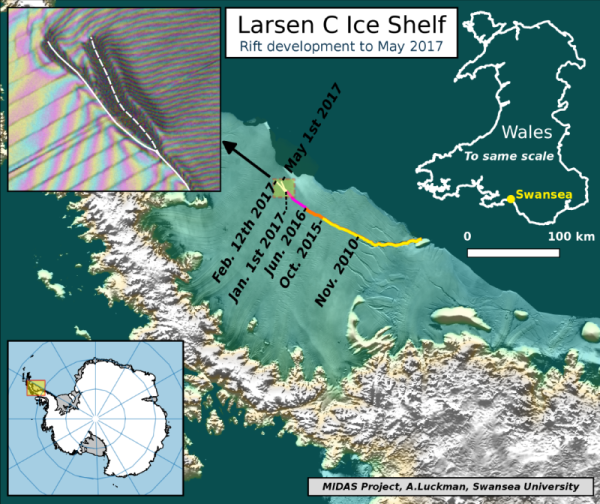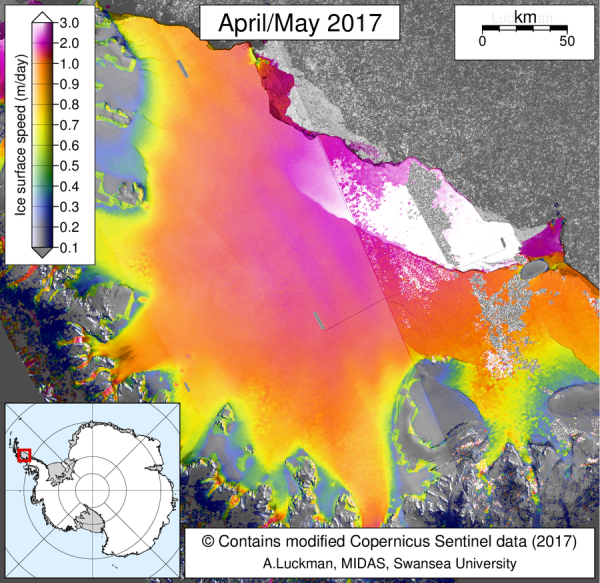New Crack Found in Delaware-Sized Chunk of Larsen C Ice Shelf as it Heads Toward Southern Ocean
A 2,000 square mile section of the Larsen C Ice Shelf is hanging by a thread as it continues to drift toward the Weddell Sea.
(A second crack develops in Larsen C Ice Shelf. Image source: Project MIDAS.)
The break-off section represents fully 10 percent of all the ice contained in the Larsen C system. It has been divided from the larger ice shelf by a 180 kilometer long crack that began to develop in 2009 and that swiftly lengthened during recent years. Now only a 10 kilometer wide bridge links the breaking section to the larger ice shelf. And considering the enormous stresses now being placed on this break-off section it is expected to go at any time.
Since January, according to researchers at Project MIDAS, the large crack has been widening but its length growth has stalled. However, recent reports out this week from MIDAS found that a new crack had developed at the ice-bridge end of the break-off section. The new crack appears to be rounding the corner of the bridge to begin a quicker path to segmenting the massive ice berg away from Larsen C. A testament to the powerful forces that are inevitably forcing this enormous section of ice to relinquish its hold.
(Large section of Larsen C is moving far faster than the rest of the ice shelf toward the Southern Ocean. Image source: Project MIDAS.)
At issue is the fact that the break-off section is moving toward the Weddell Sea considerably faster than the rest of the Larsen C ice shelf. Much of this large section of ice is proceeding away from the Antarctic mainland at 3 meters per day. Surrounding sections of Larsen C are moving at only 1-2 meters per day. As a result, the toe end of the break-off mass is tipping out into Weddell’s waters and the crack separating it from Larsen C is widening.
It’s not really a question of if this massive block of ice will separate from Larsen C. More an issue of how soon.
Loss of so large a section of ice from Larsen C threatens the entire ice shelf’s stability. And some scientists are questioning whether the whole ice shelf will destabilize and eventually splinter — as happened to Larsen A and Larsen B during recent years.
(Rapid loss of buttressing ice shelves like Larsen C lock in higher and higher ranges for sea level rise. A worrying risk for rapid sea level rise occurs as global temperatures warm to between 1.5 and 2.5 C. A level we are fast approaching. Scientists like James Hansen identify a significant risk for multi-meter sea level rise this Century if 2 C warming thresholds are breached. Video Source: Carbon Freeze.)
Warming ocean waters due to human-forced climate change are the primary driver for loss of ice shelves around the world. These ice shelves hold back land glaciers — preventing them from more rapidly sliding into the world’s oceans. Larsen C alone holds back glaciers capable of lifting global ocean levels by 4 inches. But there are numerous such ice shelves and many are now facing thinning and increasing instability due to warming ocean waters. As a result, a growing number of scientists are concerned about the possibility for multi-meter sea level rise this Century if fossil fuel burning is not swiftly halted.
Links:
Hat tip to June
Hat tip to Andy in San Diego





Geen opmerkingen:
Een reactie posten